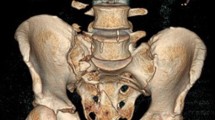Abstract
Aim
The purpose of the study was to assess the stability provided by an ilio-iliac dorsal plate fixation technique using an AO narrow DCP on the pelvic brim in vertically and rotationally unstable type-C pelvic ring injuries.
Materials and methods
We examined 12 fresh cadaver pelvises in a single limb stance load. A type-C pelvic ring injury (a type I lateral sacral fracture in the classification of Denis with symphysis pubis rupture) was performed on the cadaver specimen and fixed with a four-hole narrow dynamic compression plate to stabilize the symphysis pubis rupture; the sacrum fracture was stabilized either anteriorly with two 3-hole reconstruction plates (“anterior plate osteosynthesis”) or with a posterior fixation using a 12-hole narrow DCP. A cyclic load of between 100 and 250 N was applied to the fifth lumbar vertebra of the specimen. An extensometer was attached to both sides of the sacrum fracture to detect movements at the fracture site.
Results
We were able to achieve usable measurements in nine specimens. Three measurements were performed on each specimen, and the movements recorded at the fracture gap in trans-sacral plate fixation were higher than or similar to those observed for anterior plate synthesis in 23 out of 27 cases.
Conclusion
Dorsal ilio-iliac bridge plate fixation provides somewhat reduced stability compared to anterior plate fixation, but the difference is not significant.





Similar content being viewed by others
References
Denis F, Davis S, Comfort T. Sacral fractures: an important problem retrospective analysis of 236 cases. Clin Orthop Relat Res. 1988;227:67–81.
Gibbons K, Soloniuk D, Razack N. Neurological injury and patterns of sacral fractures. J Neurosurg. 1990;72:889–93.
Ragnarsson B, Olerud C, Olerud S. Anterior square-plate fixation of sacroiliac disruption 2–8 years follow up of 23 consecutive cases. Acta Orthop Scand. 1993;64(2):138–42.
Szita J. Experimental and clinical analysis of pelvic ring injuries (doctoral thesis). Budapest: Semmelweis University; 1992.
van Zwienen CMA, van den Bosch EW, Snijders CJ, Kleinrensink G. Biomechanical comparison of sacroiliac screw techniques for unstable pelvic ring fractures. J Orthop Trauma. 2004;18:589–95.
Schildhauer TA, Ledoux WR, Chapman JR, Henley MB, Tencer AF, Routt ML Jr. Triangular osteosynthesis and iliosacral screw fixation for unstable sacral fractures: a cadaveric and biomechanical evaluation under cyclic loads. J Orthop Trauma. 2003;17:2–31.
Sagi HC, Ordway NR, DiPasquale T. Biomechanical analysis of fixation for vertically unstable sacroiliac dislocations with iliosacral screws and symphyseal plating. J Orthop Trauma. 2004;18:138–43.
MacAvoy M, McCellan R, Trigg P, Goodman SB, Chien Chi-Ray D, Allen WA, van der Meulen MCH. Stability of open book pelvic fractures using a new biomechanical model of single-limb stance. J Orthop Trauma. 1997;11:590–3.
van den Bosch E, van Zwienen C, van den Bosch E, Hoek van Dijke GA, Snijders CJ, van Vugt AB. Sacroiliac screw fixation for tile B fractures. J Trauma. 2003;55:962–5.
Bodzay T, Burján T, Bagdi C, Flóris I, Vendégh Zs, Váradi K. Evaluation of stabilization methods of pelvic ring injuries by finite element modeling. Joint Dis Relat Surg. 2007;18(3):108–15.
Li Z, Kim J, Davidson J, Etheridge B, Alonso J, Eberhardt A. Biomechanical response of the pubic symphysis in lateral pelvic impacts: a finite element study. J Biomech. 2007;40(12):2758–66.
Hüfner T, Pohlemann T, Tarte S, Gänslen A, Geerling J, Bazak N, Citak M, Nolte LP, Krettek C. Computer-assisted fracture reduction of pelvic ring fractures: an in vitro study. Clin Orthop Relat Res. 2002;399:231–9.
Yinger K, Scalise J, Olson S, Bay B, Finkemeyer C. Biomechanical comparison of pelvic ring fixation. J Orthop Trauma. 2003;17:481–7.
Acknowledgments
The experiments were completed with the support of the Laboratory of Biomechanics, University of Debrecen. The statistical analysis was done by Jolán Józan. The graphical figures were drawn by Dr. Balázs Deák.
Conflict of interest
I, Dr. Bodzay Tamás, as author of the paper, disclose any financial or personal relationship with other people or organistions as a third party that could inappropriately influence (bias) our work, including employment, consultancies, stock ownership, honoraria, paid expert testimony, patent applications/registrations and grants or any other funding. All co-authors agree with this statement.
Author information
Authors and Affiliations
Corresponding author
About this article
Cite this article
Bodzay, T., Szita, J., Manó, S. et al. Biomechanical comparison of two stabilization techniques for unstable sacral fractures. J Orthop Sci 17, 574–579 (2012). https://doi.org/10.1007/s00776-012-0246-4
Received:
Accepted:
Published:
Issue Date:
DOI: https://doi.org/10.1007/s00776-012-0246-4




